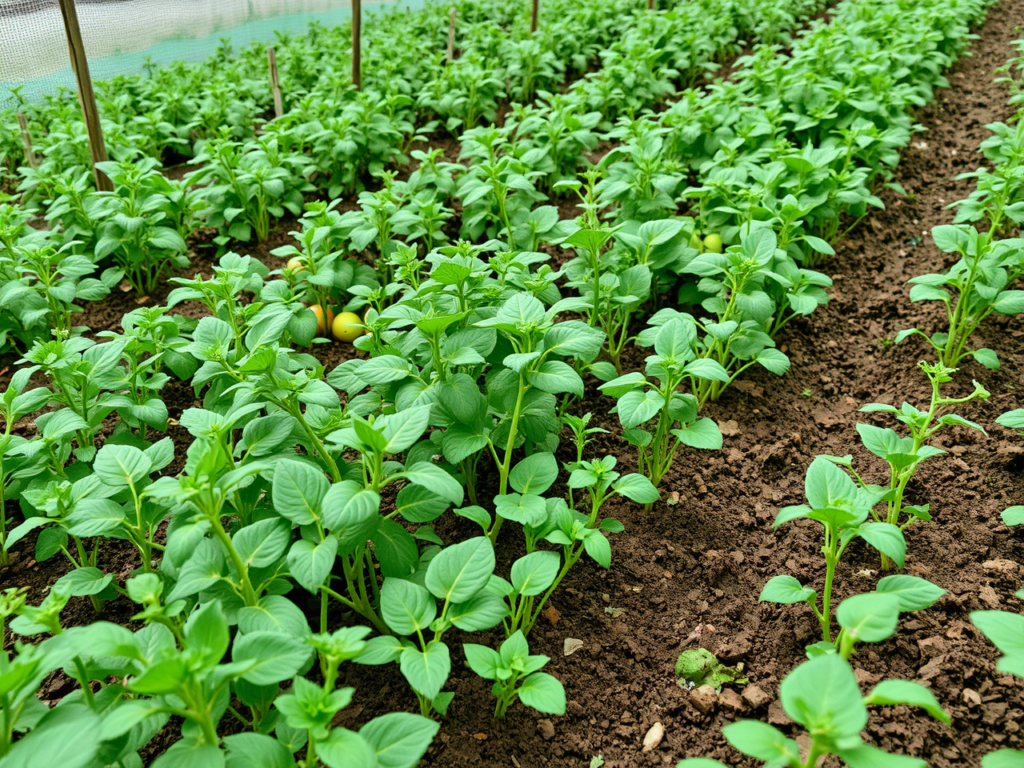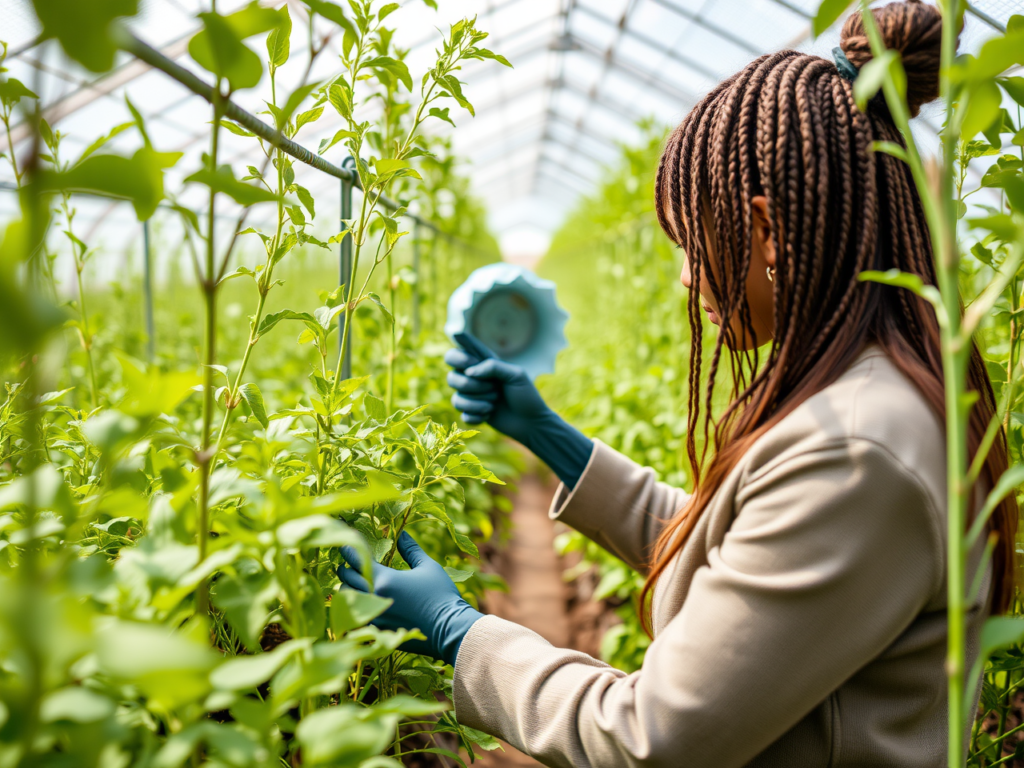A Transformational Force in Indian Farming and Beyond
Biotechnology in agriculture represents one of the most transformative forces in modern farming, blending biological sciences with advanced technological methods to improve crop productivity, disease resistance, and environmental sustainability. Agriculture, being the backbone of many economies, especially in developing nations like India, has constantly sought ways to meet the increasing demands for food while minimizing environmental impact. Biotechnology (biotech) offers innovative solutions that go beyond conventional farming methods, unlocking the potential to address global challenges such as food security, climate change, and dwindling natural resources.
Agricultural biotechnology involves manipulating living organisms, or their genetic material, to enhance crop and livestock characteristics. Genetic engineering, molecular markers, and tissue culture are some prominent tools used in modern agricultural biotechnology. Through these advancements, scientists can introduce desired traits into crops, such as resistance to pests, tolerance to harsh climatic conditions, and improved nutritional value. For instance, genetically modified (GM) crops have demonstrated significant improvements in yield and resilience, helping farmers in arid regions or pest-prone areas increase their productivity.
Table of Contents
A Transformational Force in Indian Farming and Beyond.
The Role of Biotechnology in Modern Agriculture.
The Impact of Biotechnology on Indian Agriculture.
Government Initiatives and Policies in India.
Future Prospects and Global Lessons.
In India, agriculture remains a critical sector, contributing around 18% to the national GDP and providing employment to nearly 50% of the population. However, the Indian farming landscape is plagued by challenges like fragmented land holdings, inadequate irrigation, and unpredictable weather patterns, which hinder optimal crop yields. Biotechnology offers hope to Indian farmers, presenting new tools and techniques to boost agricultural productivity while reducing dependence on chemical inputs such as fertilizers and pesticides. Indian policymakers and scientists have acknowledged the importance of biotechnology in modernizing agriculture, though it remains a topic of heated debate due to concerns around safety, ethics, and socio-economic impacts.
This article delves deeper into how biotechnology is shaping agriculture globally, with a special focus on India. We will explore its benefits, challenges, and future prospects, examining the potential for biotechnology to revolutionize Indian farming and ensure food security for future generations.
The Role of Biotechnology in Modern Agriculture
Agricultural biotechnology has introduced several groundbreaking advancements that have radically changed farming practices across the world. Some of the key areas where biotechnology has made a significant impact are:
- Genetically Modified Crops (GM Crops): GM crops are perhaps the most widely recognized result of biotechnology in agriculture. By altering the DNA of crops, scientists can develop plants that are more resilient to pests, diseases, and environmental stress. Crops such as Bt cotton, Bt brinjal, and genetically modified soybeans have shown enhanced resistance to pests like the bollworm, reducing the need for chemical pesticides. In countries like the U.S. and Brazil, GM crops have played a pivotal role in increasing yields and lowering agricultural input costs.
In India, Bt cotton is the most notable success story of GM crops. Introduced in 2002, it has helped farmers reduce pesticide use by nearly 50% while increasing yields. Today, Bt cotton accounts for over 90% of India’s cotton cultivation, helping the country become one of the world’s leading cotton producers.
- Increased Crop Yield and Quality: Biotechnology enables the development of crops with higher yields and better quality. By identifying and incorporating genes responsible for superior traits, scientists can create crops that grow faster, produce more fruit, or have enhanced nutritional content. Golden Rice, a GM rice variety rich in Vitamin A, is one example of biotechnology being used to address malnutrition. For a country like India, where food insecurity and malnutrition are still major issues, such advancements could be game-changers.
- Disease and Pest Resistance: One of the greatest threats to agricultural productivity is pests and diseases. Conventional methods of pest control, such as chemical pesticides, often lead to environmental degradation and health risks. Biotechnology offers a safer alternative by creating crops that are naturally resistant to pests and diseases. Bt crops, which contain a bacterium-derived gene that produces a toxin harmful to specific pests, are a prime example. This reduces the reliance on chemical pesticides, leading to both economic and environmental benefits for farmers.
- Climate Resilience: Climate change poses significant risks to agriculture, particularly in regions like India, where unpredictable monsoons and droughts are common. Biotechnology can help develop crops that are more tolerant to drought, salinity, and extreme temperatures, ensuring that farmers can maintain yields despite adverse weather conditions. Drought-tolerant maize, for example, has been developed using biotechnology and is being tested for its potential to withstand water-scarce conditions.
- Reduced Dependence on Chemical Inputs: Biotechnology offers the potential to reduce the need for chemical fertilizers and pesticides by creating crops that are more efficient in nutrient uptake or more resistant to pests and diseases. This can lead to a more sustainable approach to farming, with less environmental pollution and reduced soil degradation. India, with its over-reliance on chemical fertilizers, could benefit immensely from biotech solutions that promote organic and environmentally friendly farming practices.

The Impact of Biotechnology on Indian Agriculture
India, as a predominantly agrarian economy, stands to gain significantly from the adoption of biotechnology. However, the country faces unique challenges and opportunities in its pursuit of biotech-driven agricultural modernization.
- Bt Cotton: A Success Story
The introduction of Bt cotton in India is a landmark event in the country’s biotech revolution. Bt cotton, engineered to resist the bollworm pest, was approved for commercial cultivation in India in 2002. Before its introduction, cotton farmers struggled with low yields and heavy pesticide usage. Bt cotton drastically reduced the need for chemical pesticides, leading to cost savings for farmers. By 2011, India became the world’s second-largest cotton producer, largely due to the widespread adoption of Bt cotton. The success of Bt cotton has sparked debates about expanding GM technology to other crops.
- Challenges of Biotechnology in India
Despite the potential benefits, agricultural biotechnology faces numerous challenges in India. Concerns around the safety of GM crops for human consumption, environmental risks, and the economic implications for small farmers have fueled public opposition and regulatory hurdles.
a. Regulatory Environment: India’s regulatory framework for biotechnology is still evolving, with strict controls over the approval and commercialization of GM crops. The Genetic Engineering Appraisal Committee (GEAC) oversees the approval of GM crops, and its decisions are often met with public protests and legal challenges.
b. Public Perception: Public resistance to GM crops stems from concerns over potential health risks, environmental impact, and the loss of traditional farming practices. There are fears that the widespread adoption of GM seeds could lead to a monopoly by multinational corporations, potentially harming small-scale farmers.

Apple AirPods 4
c. Intellectual Property and Seed Sovereignty: The debate over intellectual property rights in biotechnology is another critical issue in India. While biotech companies invest heavily in research and development, the introduction of patented GM seeds raises concerns about seed sovereignty. Indian farmers, traditionally used to saving seeds from one harvest to the next, may face financial burdens if forced to buy patented seeds every planting season.
d. Socio-Economic Impact: Another concern is the socio-economic impact on small farmers, who may lack the financial resources to invest in biotechnology. The high cost of biotech seeds and the potential risks of crop failure due to unforeseen environmental conditions could exacerbate income disparities among farmers.
Government Initiatives and Policies in India

The Indian government has recognized the potential of biotechnology to address the country’s food security challenges. Several initiatives have been introduced to promote research, development, and commercialization of biotech solutions in agriculture.
- National Biotech Development Strategy: Launched by the Department of Biotechnology, this strategy aims to foster innovation and entrepreneurship in biotechnology, including agricultural biotechnology. It focuses on developing a skilled workforce, establishing research infrastructure, and promoting public-private partnerships.
- The Biotechnology Industry Research Assistance Council (BIRAC): BIRAC is a government agency that promotes biotech startups and innovations. Through funding and mentorship programs, BIRAC supports the development of agricultural biotechnology solutions, such as GM crops, bio-fertilizers, and bio-pesticides.
- Public-Private Partnerships: India has encouraged collaborations between public research institutions and private biotech companies to develop and commercialize biotech products. These partnerships have led to the development of several GM crops, including Bt brinjal and genetically engineered mustard, although their commercial release has been delayed due to regulatory hurdles.
- ICAR and Agricultural Research: The Indian Council of Agricultural Research (ICAR) plays a significant role in promoting agricultural biotechnology. ICAR’s research initiatives focus on developing biotech solutions that address India’s unique agricultural challenges, such as drought, salinity, and pest infestations.
- The Role of State Governments: Some Indian states have taken a more proactive approach to biotechnology adoption. For instance, states like Maharashtra and Gujarat have seen widespread adoption of Bt cotton, while others like West Bengal have resisted the introduction of GM crops like Bt brinjal due to public opposition.
Future Prospects and Global Lessons
The future of biotechnology in agriculture holds immense promise, especially for countries like India where food security and climate change are critical concerns. However, to realize this potential, several key areas need to be addressed:
- Public Awareness and Education: To overcome resistance to GM crops, governments, and scientists need to invest in educating the public about the safety and benefits of biotechnology. Addressing concerns related to health risks and environmental impact will be crucial to gaining public trust.
- Regulatory Reforms: Streamlining the regulatory process for GM crops while ensuring stringent safety assessments is necessary for faster commercialization of biotech products. A balanced regulatory framework can foster innovation while safeguarding public and environmental health.
- Biotechnology for Sustainable Agriculture: Biotechnology must be leveraged to promote sustainable agricultural practices, such as organic farming, precision agriculture, and the development of crops that require fewer inputs. This will help mitigate the environmental impact of conventional farming methods and ensure long-term agricultural productivity.
- Global Collaboration: India can benefit from global collaborations in agricultural biotechnology, learning from the experiences of countries like the U.S., Brazil, and China, where GM crops have been widely adopted. International partnerships can facilitate knowledge exchange, technology transfer, and joint research initiatives to address global agricultural challenges.
- Focus on Smallholder Farmers: Biotechnology solutions should be tailored to the needs of smallholder farmers, who make up the majority of India’s agricultural workforce. Developing affordable and accessible biotech products will ensure that small farmers can also benefit from technological advancements.
To 20 FAQs
Here are the top 20 frequently asked questions (FAQs) about “Biotechnology in Agriculture” in the context of the Indian subcontinent. These FAQs cover the key aspects of biotechnology in agriculture specific to the Indian subcontinent, addressing both its potential and the challenges faced.
- What is agricultural biotechnology?
- Agricultural biotechnology refers to the use of scientific techniques, such as genetic engineering, molecular markers, and tissue culture, to improve crop yields, pest resistance, and overall agricultural productivity.
- How does biotechnology benefit Indian agriculture?
- Biotechnology in Indian agriculture helps in increasing crop yields, enhancing pest and disease resistance, improving nutritional content, and ensuring climate-resilient crops, thereby addressing food security and sustainability.
- What are genetically modified (GM) crops, and are they used in India?
- GM crops are plants whose genetic material has been altered to exhibit desirable traits, such as pest resistance or drought tolerance. In India, Bt cotton is the most widely used GM crop.
- Is Bt cotton the only GM crop in India?
- Yes, Bt cotton is the only commercially approved GM crop in India. Other GM crops like Bt brinjal and GM mustard are still awaiting approval.
- What are the main concerns regarding the use of GM crops in India?
- Concerns include potential health risks, environmental impacts, loss of biodiversity, corporate control of seeds, and the economic effects on small farmers.

- How can biotechnology help Indian farmers deal with climate change?
- Biotechnology can help develop climate-resilient crops that can withstand extreme weather conditions like droughts, floods, and salinity, which are common in India due to climate change.
- What is the role of the Indian government in promoting agricultural biotechnology?
- The Indian government promotes agricultural biotechnology through initiatives like the National Biotech Development Strategy, funding for biotech research, and public-private partnerships.
- What is the regulatory framework for GM crops in India?
- In India, the Genetic Engineering Appraisal Committee (GEAC) oversees the approval and regulation of GM crops, ensuring safety assessments are conducted before commercialization.
- Are GM crops safe for human consumption?
- Scientific studies have shown that GM crops approved for commercialization undergo rigorous safety assessments, and are considered safe for human consumption. However, public skepticism and regulatory concerns remain in India.
- How do GM crops impact the environment?
- GM crops can reduce the need for chemical pesticides and fertilizers, thereby reducing environmental pollution. However, concerns about unintended ecological consequences, such as cross-contamination with non-GM plants, persist.
- What is the current status of GM mustard in India?
- GM mustard, a crop developed to increase yields and reduce dependence on imports, is under regulatory review and has yet to be approved for commercial cultivation in India.
- How can biotechnology help address food security in the Indian subcontinent?
- Biotechnology can increase agricultural productivity, reduce crop losses due to pests and diseases, and improve the nutritional content of food, which can help address food security challenges in India and neighboring countries.
- What are the ethical concerns surrounding biotechnology in agriculture?
- Ethical concerns include the potential for monopolies by large biotech companies, the loss of traditional farming practices, and the socioeconomic impact on small-scale farmers.
- What role does intellectual property play in agricultural biotechnology in India?
- Intellectual property laws related to biotech seeds can affect seed sovereignty for Indian farmers, as patented GM seeds may require farmers to purchase new seeds every season, potentially increasing costs.
- Can organic farming and biotechnology coexist in India?
- While some argue that organic farming and biotechnology are incompatible, biotechnology can contribute to sustainable farming practices, such as reducing chemical inputs, which can complement organic farming in certain contexts.
- What are the key challenges in adopting biotechnology in Indian agriculture?
- Key challenges include public resistance, regulatory hurdles, lack of awareness, high seed costs, and the uncertain socio-economic impact on smallholder farmers.

- How can small farmers in India benefit from biotechnology?
- Small farmers can benefit from higher yields, reduced pest damage, and lower costs associated with reduced pesticide use. However, affordability and accessibility of biotech seeds are critical factors for their success.
- What is Golden Rice, and can it benefit India?
- Golden Rice is a genetically modified variety of rice enriched with Vitamin A, designed to combat malnutrition. While it could benefit India by addressing Vitamin A deficiency, it is not yet commercially available in the country.
- What role does the Indian Council of Agricultural Research (ICAR) play in biotech advancements?
- ICAR plays a crucial role in research and development related to agricultural biotechnology, focusing on developing biotech solutions for issues like drought resistance, pest control, and crop productivity in India.
- What are the future prospects of biotechnology in Indian agriculture?
- The future of biotechnology in India holds promise for improved food security, sustainability, and climate resilience. However, public education, regulatory reforms, and a focus on smallholder farmers will be crucial for its success.
Conclusion
Biotechnology in agriculture is reshaping the future of farming, offering innovative solutions to some of the most pressing challenges, such as food security, climate change, and environmental sustainability. In India, the potential for agricultural biotechnology is enormous, but realizing this potential will require addressing regulatory, socio-economic, and public perception challenges.
The success of Bt cotton has already demonstrated the power of biotechnology to improve productivity and reduce environmental impact. However, expanding biotechnology to other crops and regions in India will require robust public awareness campaigns, clear regulatory frameworks, and a focus on the needs of smallholder farmers.
By embracing agricultural biotechnology responsibly, India can not only enhance its agricultural productivity but also contribute to global food security and sustainable development. The future of Indian agriculture, supported by biotechnology, holds the promise of more resilient, productive, and sustainable farming systems that can meet the demands of a growing population while preserving the environment.
Interesting reads





